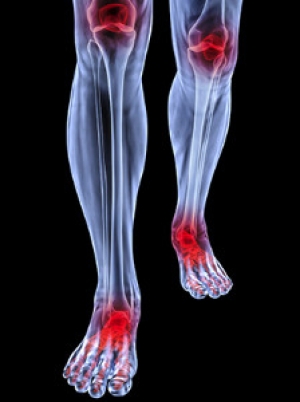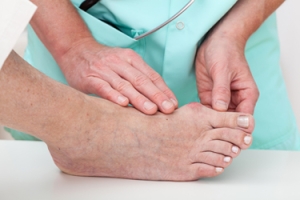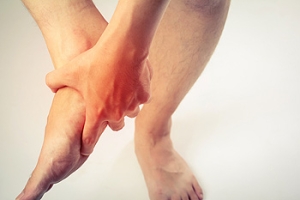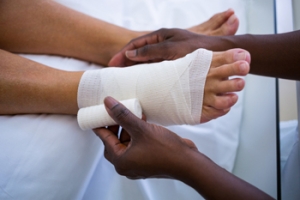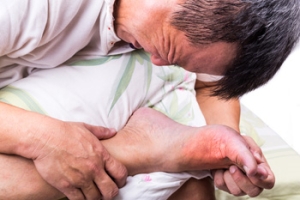
Rheumatoid Arthritis in the Feet
Rheumatoid Arthritis is a chronic progressive disease that attacks several joints throughout the body. It is an autoimmune disease in which the body’s immune system mistakenly attacks the joints. As a result, the tissue inside the joints, called synovium, starts to thicken and causes pain around the joints. The synovium is responsible for creating a fluid that lubricates the joints to help them move. Approximately 1.5 million people in the United States have Rheumatoid Arthritis. Women are almost three times as likely to have RA compared to men, and it’s disease usually begins between the ages of 30 and 60. People who have a genetic history of RA are more likely to develop the disease.
Symptoms of RA may include the following sensations in the joints: pain, tenderness, swelling, redness, warmth, stiffness, and loss of range. Swollen joints are a very common symptom for those with the disease. At times, it may be minimal, but it may also be very apparent. Another typical symptom is joint stiffness. Doctors will often use the direction of morning stiffness to measure the severity of a patient’s joint inflammation. Other RA symptoms include limping, anemia, fever, and fatigue.
To diagnose RA, your podiatrist will typically request x-rays to see how much damage there is in the joints. Blood tests may also be performed to show if there are any signs of anemia, or antibodies such as the rheumatoid factor. If you have previously been diagnosed with RA, you should know the disease may spread to your feet and ankles.
There are many non-surgical options that can be used to treat this ailment. Some of these options include physical therapy, foot massages, orthotics, bracing, supportive shoes, and steroid injections. Physical therapy is useful because it will help stretch and strengthen the joints in both the foot and ankle to improve joint function. Massages can help improve blood circulation which will be good for the feet. Choosing proper footwear will allow you to walk with comfortability if you are a sufferer from RA. Lastly, bracing will help stabilize the foot joints, limit deformities and decrease pain.
In severe cases, surgery may be a treatment option that should be considered. For those who cannot walk without experiencing pain and those whose deformities can not be managed with braces, surgery should be considered. Your podiatrist will recommend surgery if he or she believes it will improve your foot biomechanics.
How Does Arthritis Affect the Feet?
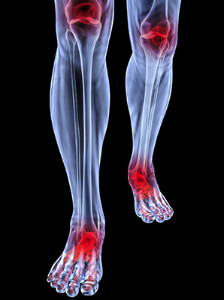 Patients who have arthritis in the feet are familiar with the pain and discomfort this may cause. The toes are typically affected, and symptoms can include swelling, pain while trying to lift them, and difficulty walking. If the joints on the toes rub together, friction may cause a small bump to develop. In severe cases, the toenails may become separated from the nail bed, and there may be aches and pains in the overall foot. A common form of arthritis in the feet is known as gout, and it may develop from the types of foods that are eaten. The autoimmune disease that is referred to as psoriasis can produce psoriatic arthritis, and many patients who are afflicted with this may notice stiff joints followed by uncomfortable skin conditions. If you have developed arthritis in the feet, please consult with a podiatrist who can help you with proper treatment techniques.
Patients who have arthritis in the feet are familiar with the pain and discomfort this may cause. The toes are typically affected, and symptoms can include swelling, pain while trying to lift them, and difficulty walking. If the joints on the toes rub together, friction may cause a small bump to develop. In severe cases, the toenails may become separated from the nail bed, and there may be aches and pains in the overall foot. A common form of arthritis in the feet is known as gout, and it may develop from the types of foods that are eaten. The autoimmune disease that is referred to as psoriasis can produce psoriatic arthritis, and many patients who are afflicted with this may notice stiff joints followed by uncomfortable skin conditions. If you have developed arthritis in the feet, please consult with a podiatrist who can help you with proper treatment techniques.
Arthritis can be a difficult condition to live with. If you are seeking treatment, contact one of our podiatrists from PA Foot & Ankle Associates. Our doctors can provide the care you need to keep you pain-free and on your feet.
Arthritic Foot Care
Arthritis is a joint disorder that involves the inflammation of different joints in your body, such as those in your feet. Arthritis is often caused by a degenerative joint disease and causes mild to severe pain in all affected areas. In addition to this, swelling and stiffness in the affected joints can also be a common symptom of arthritis.
In many cases, wearing ill-fitting shoes can worsen the effects and pain of arthritis. Wearing shoes that have a lower heel and extra room can help your feet feel more comfortable. In cases of rheumatoid arthritis, the arch in your foot may become problematic. Buying shoes with proper arch support that contour to your feet can help immensely.
Alleviating Arthritic Pain
- Exercises that stretch the foot can prevent further pain and injury and increase mobility
- Most of the pain can be alleviated with anti-inflammatory drugs, heat, and topical medications
- Massages can help temporarily alleviate pain.
It is best to see your doctor for the treatment that is right for your needs and symptoms. Conditions vary, and a podiatrist can help you determine the right method of care for your feet.
If you have any questions, please feel free to contact one of our offices located in Allentown, Easton, Northampton, and Chew Street in Allentown, PA . We offer the newest diagnostic tools and technology to treat your foot and ankle needs.
Arthritic Foot Care
During your lifetime, you will probably walk about 75,000 miles, which is quite a lot of stress to put on your feet. As you get older, the 26 bones and 30 joints in each of your feet will lose flexibility and elasticity. Your foot’s natural shock absorbers will wear down as well. Having arthritis added to this mix only makes matters worse. Your joints will become distorted and inflamed, which is why arthritic foot care needs to be something to think about every day.
When dealing with arthritis, having additional foot complications, such as bunions, hammertoes, or neuroma, can be a serious detriment. To avoid these, buy well-fitting shoes with a lower heel and good support. Arthritis causes you to lose your arch, so having shoes with good arch support is also highly recommended.
Aside from getting good arch support, the shoes need to fit comfortably and properly as well. A good place to start is by leaving a finger width between the back of the shoe and your foot to gauge proper size. It is also helpful to have a square or rounded toe box in the front to provide even more comfort. Another thing to look for is a rubber sole that can provide a cushion and absorb shock as you walk. This adds flexibility to the ball of your foot when you push off your heel to walk.
Exercise is another key aspect of arthritic foot care. Exercise not only strengthens and stretches your muscles and joints, but helps to prevent further injury and pain as well. Stretching the Achilles tendon, the tendon located in the back of your heel, will give you added mobility and reduce pain due to stress. Another thing you can do is massage your feet, kneading the ball of your foot as well as your toes from top to bottom.
Stretching the Achilles tendon is a simple exercise that you can do at home anytime. Lean against the wall with your palms flat against the surface while placing one foot forward, towards the wall, and one foot behind you. Bend your forward knee towards the wall while keeping your back knee locked straight, and make sure both your heels are completely touching the ground at all times. This will stretch your Achilles tendon and calf muscles as well. You will feel the stretch almost immediately. You can also stretch your toes in a couple ways. One involves taking a rubber band and wrapping it around both your big toes while your heels remain together. Then, pull them apart to stretch your big toe. You can also place a rubber band around all the toes of one of your feet. Then, try to separate each individual toe, stretching them all.
A final step you can take to help your arthritis is taking non-steroid, non-inflammatory drugs or topical medicines with capsaicin. Unfortunately, there is no complete way to remove all of your arthritic pain. However, following some of this advice can go a long way in staying as pain-free as possible.
How Does Gout Occur?
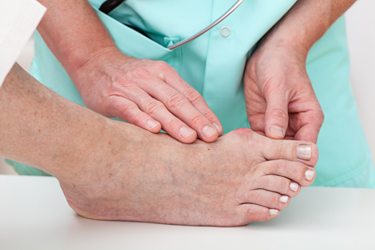 A form of arthritis that is referred to as gout, typically causes severe pain and discomfort. It occurs as a result of excess levels of uric acid in the bloodstream, and can be caused by eating foods that are high in purines. These types of foods can include shellfish, red meat, alcohol, or sugary foods and drinks. The pain is caused by crystals that form between the joints of the big toe, which can make it feel like there are small needles inside the toe. Gout may be prevented by eating foods that are healthy and drinking plenty of water. Additionally, it may be beneficial to incorporate a gentle exercise routine into your daily activities. If you have gout attacks, it is strongly recommended that you are under the care of a podiatrist who can properly treat this painful condition.
A form of arthritis that is referred to as gout, typically causes severe pain and discomfort. It occurs as a result of excess levels of uric acid in the bloodstream, and can be caused by eating foods that are high in purines. These types of foods can include shellfish, red meat, alcohol, or sugary foods and drinks. The pain is caused by crystals that form between the joints of the big toe, which can make it feel like there are small needles inside the toe. Gout may be prevented by eating foods that are healthy and drinking plenty of water. Additionally, it may be beneficial to incorporate a gentle exercise routine into your daily activities. If you have gout attacks, it is strongly recommended that you are under the care of a podiatrist who can properly treat this painful condition.
Gout is a painful condition that can be treated. If you are seeking treatment, contact one of our podiatrists from PA Foot & Ankle Associates. Our doctors will treat your foot and ankle needs.
What Is Gout?
Gout is a form of arthritis that is characterized by sudden, severe attacks of pain, redness, and tenderness in the joints. The condition usually affects the joint at the base of the big toe. A gout attack can occur at any random time, such as the middle of the night while you are asleep.
Symptoms
- Intense Joint Pain - Usually around the large joint of your big toe, and it most severe within the first four to twelve hours
- Lingering Discomfort - Joint discomfort may last from a few days to a few weeks
- Inflammation and Redness -Affected joints may become swollen, tender, warm and red
- Limited Range of Motion - May experience a decrease in joint mobility
Risk Factors
- Genetics - If family members have gout, you’re more likely to have it
- Medications - Diuretic medications can raise uric acid levels
- Gender/Age - Gout is more common in men until the age of 60. It is believed that estrogen protects women until that point
- Diet - Eating red meat and shellfish increases your risk
- Alcohol - Having more than two alcoholic drinks per day increases your risk
- Obesity - Obese people are at a higher risk for gout
Prior to visiting your podiatrist to receive treatment for gout, there are a few things you should do beforehand. If you have gout you should write down your symptoms--including when they started and how often you experience them, important medical information you may have, and any questions you may have. Writing down these three things will help your podiatrist in assessing your specific situation so that he or she may provide the best route of treatment for you.
If you have any questions, please feel free to contact one of our offices located in Allentown, Easton, Northampton, and Chew Street in Allentown, PA . We offer the newest diagnostic and treatment technologies for all your foot care needs.
Everything You Need to Know About Gout
Gout, typically found in diabetic patients, is an unusually painful form of arthritis caused by elevated levels of uric acid in the bloodstream. The condition typically strikes the big joint on the big toe. It has also been known to strike the knees, elbows, fingers, ankles and wrists—generally anywhere that has a functioning, moving joint.
The high level of uric acid in a person’s bloodstream creates the condition known as hyperuricema—the main cause of gout. Genetic predisposition occurs in nine out of ten sufferers. The children of parents who suffer gout will have a two in ten chance of developing the condition as well.
This form of arthritis, being particularly painful, is the leftover uric acid crystallizing in the blood stream. The crystallized uric acid then travels to the space between joints where they rub, causing friction when the patient moves. Symptoms include: pain, redness, swelling, and inflammation. Additional side effects may include fatigue and fever, although reports of these effects are very rare. Some patients have reported that pain may intensify when the temperature drops, such as when you sleep.
Most cases of gout are easily diagnosed by a podiatrist’s assessment of the various symptoms. Defined tests can also be performed. A blood test to detect elevated levels of uric acid is often used as well as an x-ray to diagnose visible and chronic gout.
Treatment for gout simply means eliminating symptoms. Non-steroid anti-inflammatory drugs or NSAIDs (Colchicine and other corticosteroid drugs, etc.) will quell the redness, the swelling, and the inflammation. However, managing your diet, lifestyle changes, and using preventative drugs are all helpful toward fully combating the most severe cases.
Those that lead an inactive lifestyle are at a higher risk for gout. Any amount of exercise decreases the probability of repeat encounters with the condition. Reducing your consumption of red meat, sea food, and fructose-sweetened drinks also reduces the likelihood of chronic gout as well.
Ingesting Vitamin C, coffee, and particular dairy products can help with maintaining a healthy lifestyle. There are new drugs out on the market that inhibit the body’s production of uric acid-producing enzymes. However, reducing or eliminating your overall levels of uric acid is the best remedy to ensuring you lead a gout-free life.
Common Types of Foot Pain
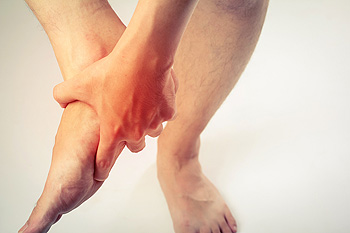 The feet are considered to be the foundation of the body, and may feel aches and pains from performing daily activities. Many types of foot pain can be caused by poor foot structure, or from wearing shoes that do not fit correctly. A common form of pain can be found in the heel, which may be indicative of plantar fasciitis or a heel spur. The condition that is referred to as flat feet may cause pain in the middle of the foot, where the arch would generally be found. Patients have found moderate relief when custom-made insoles are worn, which may provide the support that is needed. Bunions may cause pain as a result of inflammation, and can become irritated as the affected part of the foot rubs against the shoe. If you experience any discomfort in your feet, it is strongly advised that you schedule a consultation with a podiatrist as quickly as possible who can determine the cause and offer treatment options.
The feet are considered to be the foundation of the body, and may feel aches and pains from performing daily activities. Many types of foot pain can be caused by poor foot structure, or from wearing shoes that do not fit correctly. A common form of pain can be found in the heel, which may be indicative of plantar fasciitis or a heel spur. The condition that is referred to as flat feet may cause pain in the middle of the foot, where the arch would generally be found. Patients have found moderate relief when custom-made insoles are worn, which may provide the support that is needed. Bunions may cause pain as a result of inflammation, and can become irritated as the affected part of the foot rubs against the shoe. If you experience any discomfort in your feet, it is strongly advised that you schedule a consultation with a podiatrist as quickly as possible who can determine the cause and offer treatment options.
Foot Pain
Foot pain can be extremely painful and debilitating. If you have a foot pain, consult with one of our podiatrists from PA Foot & Ankle Associates. Our doctors will assess your condition and provide you with quality foot and ankle treatment.
Causes
Foot pain is a very broad condition that could be caused by one or more ailments. The most common include:
- Bunions
- Hammertoes
- Plantar Fasciitis
- Bone Spurs
- Corns
- Tarsal Tunnel Syndrome
- Ingrown Toenails
- Arthritis (such as Gout, Rheumatoid, and Osteoarthritis)
- Flat Feet
- Injury (from stress fractures, broken toe, foot, ankle, Achilles tendon ruptures, and sprains)
- And more
Diagnosis
To figure out the cause of foot pain, podiatrists utilize several different methods. This can range from simple visual inspections and sensation tests to X-rays and MRI scans. Prior medical history, family medical history, and any recent physical traumatic events will all be taken into consideration for a proper diagnosis.
Treatment
Treatment depends upon the cause of the foot pain. Whether it is resting, staying off the foot, or having surgery; podiatrists have a number of treatment options available for foot pain.
If you have any questions, please feel free to contact one of our offices located in Allentown, Easton, Northampton, and Chew Street in Allentown, PA . We offer the newest diagnostic and treatment technologies for all your foot care needs.
Foot Pain
Our feet are arguably the most important parts of our bodies because they are responsible for getting us from place to place. However, we often don’t think about our feet until they begin to hurt. If you have pain in your feet, you need to first determine where on the foot you are experiencing it to get to the root of the problem. The most common areas to feel pain on the foot are the heel and the ankle.
Heel pain is most commonly attributed to a condition called plantar fasciitis. Plantar fasciitis occurs when the plantar fascia, which is the band of tough tissue connecting the heel bone to the toes becomes inflamed. Plantar fasciitis pain is usually worse in the morning, and it tends to go away throughout the day. If you have plantar fasciitis, you should rest your foot and do heel and foot muscles stretches. Wearing shoes with proper arch support and a cushioned sole has also been proven to be beneficial.
Some common symptoms of foot pain are redness, swelling, and stiffness. Foot pain can be dull or sharp depending on its underlying cause. Toe pain can also occur, and it is usually caused by gout, bunions, hammertoes, ingrown toenails, sprains, fractures, and corns.
If you have severe pain in your feet, you should immediately seek assistance from your podiatrist for treatment. Depending on the cause of your pain, your podiatrist may give you a variety of treatment options.
Wounds on the Feet Can Lead to Infection
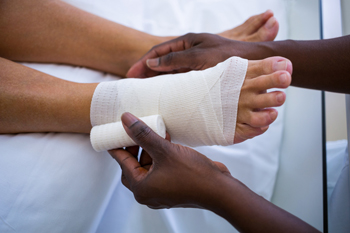 A wound on the foot typically needs immediate attention, and this is especially true for diabetic patients. A wound may develop into a foot ulcer, which can lead to an infection, gangrene, and possibly amputation. There are some noticeable signs that are indicative of a foot wound. These can include cracked skin, cuts, blisters, or wounds may occur as a result of an existing condition, such as an ingrown toenail. An infected wound can be accompanied by swollen glands, a general feeling of malaise, or there may be drainage coming from the affected area. The wound needs to be cleaned promptly, which can be done by washing the foot in warm water, followed by covering it with a sterile bandage. If you have wounds on your feet, it is strongly advised that you are under the care of a podiatrist who can properly treat this condition.
A wound on the foot typically needs immediate attention, and this is especially true for diabetic patients. A wound may develop into a foot ulcer, which can lead to an infection, gangrene, and possibly amputation. There are some noticeable signs that are indicative of a foot wound. These can include cracked skin, cuts, blisters, or wounds may occur as a result of an existing condition, such as an ingrown toenail. An infected wound can be accompanied by swollen glands, a general feeling of malaise, or there may be drainage coming from the affected area. The wound needs to be cleaned promptly, which can be done by washing the foot in warm water, followed by covering it with a sterile bandage. If you have wounds on your feet, it is strongly advised that you are under the care of a podiatrist who can properly treat this condition.
Wound care is an important part in dealing with diabetes. If you have diabetes and a foot wound or would like more information about wound care for diabetics, consult with one of our podiatrists from PA Foot & Ankle Associates. Our doctors will assess your condition and provide you with quality foot and ankle treatment.
What Is Wound Care?
Wound care is the practice of taking proper care of a wound. This can range from the smallest to the largest of wounds. While everyone can benefit from proper wound care, it is much more important for diabetics. Diabetics often suffer from poor blood circulation which causes wounds to heal much slower than they would in a non-diabetic.
What Is the Importance of Wound Care?
While it may not seem apparent with small ulcers on the foot, for diabetics, any size ulcer can become infected. Diabetics often also suffer from neuropathy, or nerve loss. This means they might not even feel when they have an ulcer on their foot. If the wound becomes severely infected, amputation may be necessary. Therefore, it is of the upmost importance to properly care for any and all foot wounds.
How to Care for Wounds
The best way to care for foot wounds is to prevent them. For diabetics, this means daily inspections of the feet for any signs of abnormalities or ulcers. It is also recommended to see a podiatrist several times a year for a foot inspection. If you do have an ulcer, run the wound under water to clear dirt from the wound; then apply antibiotic ointment to the wound and cover with a bandage. Bandages should be changed daily and keeping pressure off the wound is smart. It is advised to see a podiatrist, who can keep an eye on it.
If you have any questions, please feel free to contact one of our offices located in Allentown, Easton, Northampton, and Chew Street in Allentown, PA . We offer the newest diagnostic and treatment technologies for all your foot care needs.
Wound Care
Diabetics must be wary of all wounds, regardless of depth or size. Diabetes, a chronic disease in which the body cannot properly use glucose the way it normally would, causes various complications that make wounds difficult to heal. Nerve damage or neuropathy will cause diabetics to have trouble feeling the pain of a blister or cut until the condition has significantly worsened or become infected. A diabetic’s weakened immune system can make even the most minor of wounds easily susceptible to infection. Diabetics are also more prone to developing narrow, clogged arteries, and are therefore more likely to develop wounds.
Wounds should be taken care of immediately after discovery, as even the smallest of wounds can become infected if enough bacteria build up within the wound. To remove dirt, wounds should be first rinsed under running water only. Soap, hydrogen peroxide, or iodine can irritate the injury and should be avoided. To prevent infection, apply antibiotic ointment to the wound and cover it with a bandage. The bandage should be changed daily. The skin around the wound may be cleaned with soap.
To prevent further exacerbation, see a doctor—especially if you have diabetes. Minor skin conditions can become larger problems if not properly inspected. As the wound heals, make sure to avoid applying pressure to the affected area.
Foot Pain May Be a Result of Certain Medical Conditions
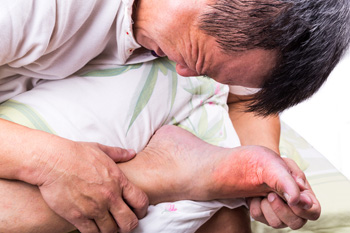 Many patients will experience swollen ankles or swollen feet periodically throughout their lives. This can happen for a variety of reasons, including a possible injury, arthritic conditions, or medical issues that may involve the kidneys. The foot will swell immediately if it is sprained or broken, which may cause pain and discomfort. Swollen feet may be a common condition among patients who have heart ailments. When this occurs, fluid may collect in the feet and ankles. Gravity can cause this to become worse during the day, so it may help to elevate the feet as often as possible. The arthritic condition that is known as gout can cause extreme foot pain. It typically affects the big toe, and may cause pain that is so extreme, it can be difficult to touch the toe. If you have any type of foot pain, it is strongly advised that you speak with a podiatrist as quickly as possible so they can help you to feel better.
Many patients will experience swollen ankles or swollen feet periodically throughout their lives. This can happen for a variety of reasons, including a possible injury, arthritic conditions, or medical issues that may involve the kidneys. The foot will swell immediately if it is sprained or broken, which may cause pain and discomfort. Swollen feet may be a common condition among patients who have heart ailments. When this occurs, fluid may collect in the feet and ankles. Gravity can cause this to become worse during the day, so it may help to elevate the feet as often as possible. The arthritic condition that is known as gout can cause extreme foot pain. It typically affects the big toe, and may cause pain that is so extreme, it can be difficult to touch the toe. If you have any type of foot pain, it is strongly advised that you speak with a podiatrist as quickly as possible so they can help you to feel better.
Foot Pain
Foot pain can be extremely painful and debilitating. If you have a foot pain, consult with one of our podiatrists from PA Foot & Ankle Associates. Our doctors will assess your condition and provide you with quality foot and ankle treatment.
Causes
Foot pain is a very broad condition that could be caused by one or more ailments. The most common include:
- Bunions
- Hammertoes
- Plantar Fasciitis
- Bone Spurs
- Corns
- Tarsal Tunnel Syndrome
- Ingrown Toenails
- Arthritis (such as Gout, Rheumatoid, and Osteoarthritis)
- Flat Feet
- Injury (from stress fractures, broken toe, foot, ankle, Achilles tendon ruptures, and sprains)
- And more
Diagnosis
To figure out the cause of foot pain, podiatrists utilize several different methods. This can range from simple visual inspections and sensation tests to X-rays and MRI scans. Prior medical history, family medical history, and any recent physical traumatic events will all be taken into consideration for a proper diagnosis.
Treatment
Treatment depends upon the cause of the foot pain. Whether it is resting, staying off the foot, or having surgery; podiatrists have a number of treatment options available for foot pain.
If you have any questions, please feel free to contact one of our offices located in Allentown, Easton, Northampton, and Chew Street in Allentown, PA . We offer the newest diagnostic and treatment technologies for all your foot care needs.
